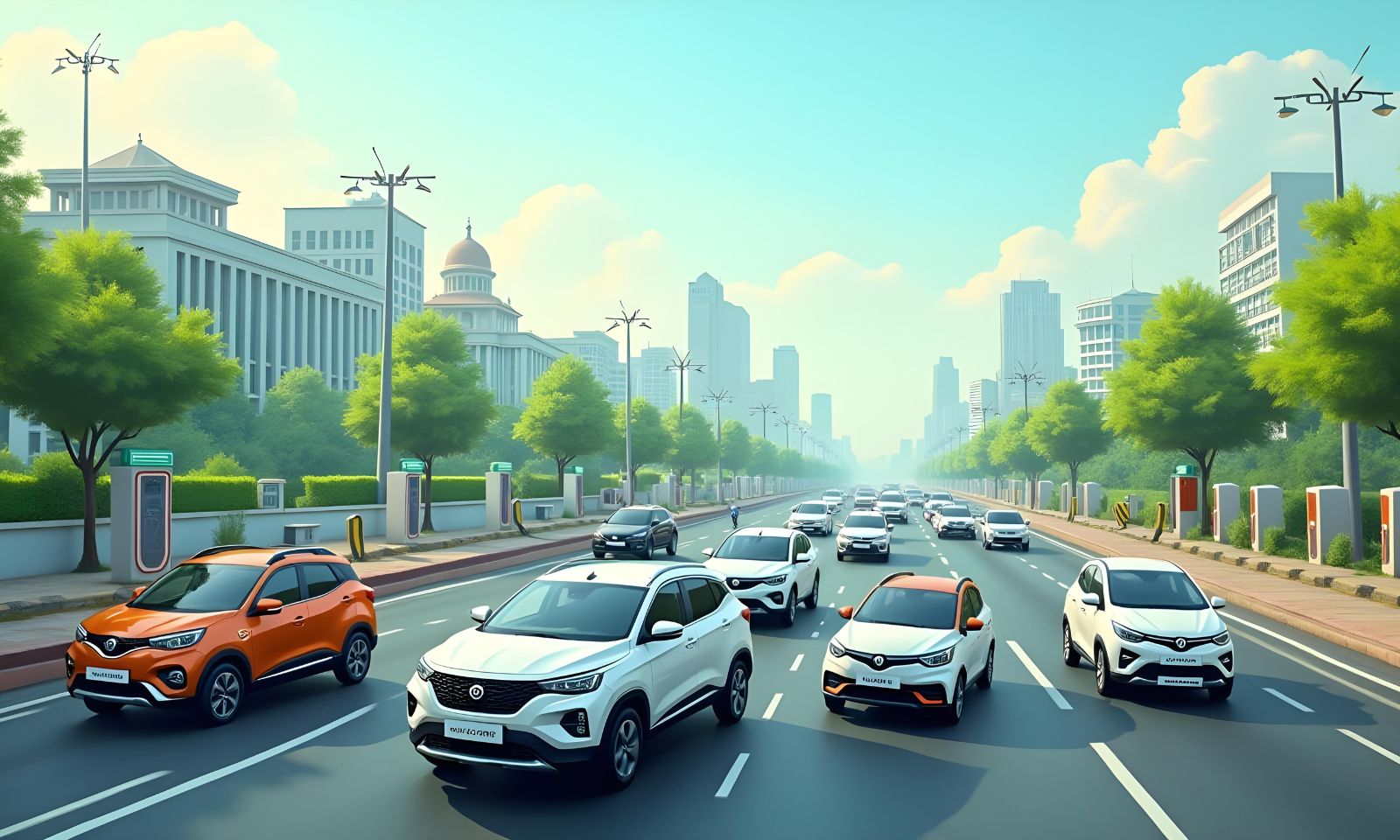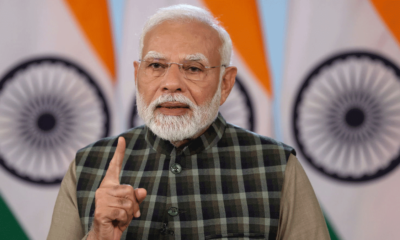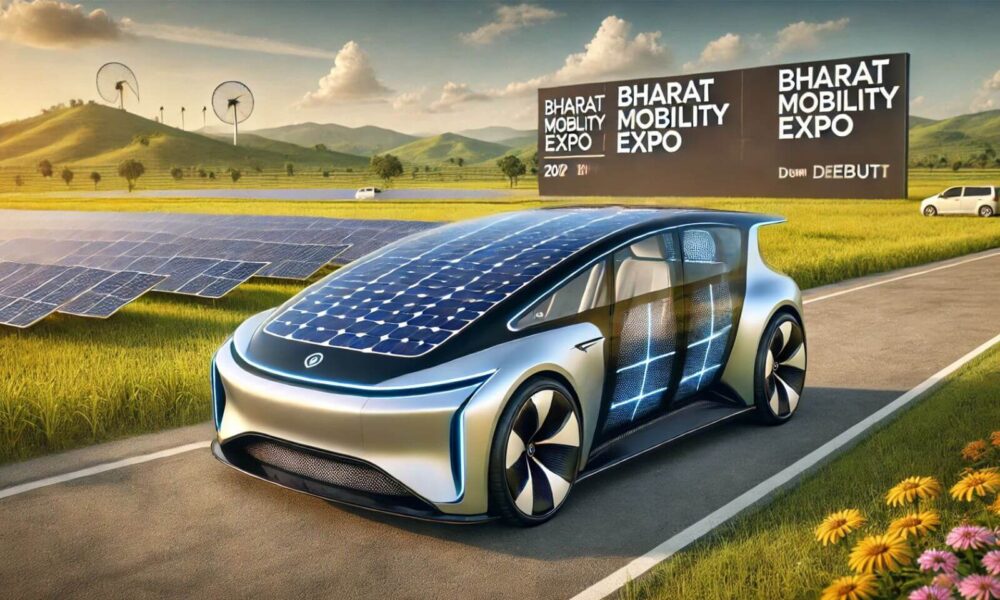EV
India’s First Solar-Powered EV: A New Era for Sustainable Transport
India’s first solar-powered electric vehicle is set to transform sustainable transportation by reducing carbon emissions and offering a cleaner, cost-effective solution for the future.

India is set to make a significant leap toward sustainable transport with the launch of its first solar-powered EV at the Bharat Mobility Expo. This groundbreaking innovation aims to revolutionize the country’s automotive industry by offering a greener, more efficient alternative to traditional vehicles.
With rising pollution and heavy dependence on fossil fuels, this solar-powered EV is an important step toward cleaner transportation. By utilizing India’s abundant sunlight, the vehicle aims to reduce carbon emissions while providing a cost-effective solution to transportation challenges. This renewable energy vehicle could pave the way for a greener future on India’s roads, helping the country achieve its green mobility goals.
“Key Features and Innovations”
This solar-powered EV is designed with cutting-edge technology.
High-efficiency solar panels are built into the car, allowing it to convert sunlight into energy. This energy is stored in advanced lithium-ion batteries, providing a reliable power source that doesn’t rely entirely on charging stations. This improves energy sustainability, making it a great option for both urban and rural drivers.
Key features include:
• Solar Panel Integration: Efficient panels that capture maximum solar energy.
• Enhanced Battery Efficiency: Long-lasting lithium-ion batteries for longer travel distances.
• Dual Charging Mode: A backup charging option to ensure power during low sunlight.
• Smart Energy Management: AI technology to optimize energy use and improve vehicle performance.
“A Turning Point for India’s Automotive Industry”
The introduction of this solar-powered EV could transform India’s automotive market.
Government initiatives, like the FAME (Faster Adoption and Manufacturing of Hybrid and Electric Vehicles) scheme, are already driving the adoption of electric vehicles in India. Solar-powered EVs offer a solution to key challenges, such as reliance on charging stations and range anxiety.
In addition, the affordability of solar energy makes these vehicles more accessible, helping to drive EV adoption across a broader audience. The launch supports India’s goal to reduce greenhouse gas emissions and reach carbon neutrality by 2070. This marks a major step in the nation’s journey toward sustainable transport and green mobility.
“Challenges and Opportunities”
Despite its promise, the solar-powered EV faces a few challenges.
The effectiveness of solar panels can be impacted by weather conditions, especially during the monsoon season, which could reduce energy generation. Additionally, the initial cost of the vehicle may be higher due to the advanced technology. However, as production increases and with government incentives, these issues can be addressed, making renewable energy vehicles more accessible.
“A Vision for a Greener Future”
India’s first solar-powered EV is more than just a technological achievement; it’s a step toward a cleaner, more sustainable future. By using renewable energy, this innovation helps tackle environmental concerns and sets the foundation for solar-powered transportation in the future.
As the world continues to focus on climate change, India’s move into solar-powered vehicles positions the country as a leader in renewable energy solutions. The unveiling of this EV at the Bharat Mobility Expo will inspire further innovations in green technology.
India’s solar-powered EV is a symbol of progress and hope, lighting the way toward a more sustainable future for generations to come.
Watch and Subscribe to the YouTube Channel: EBT Entrepreneur Business Times
EV
India’s Electric Vehicle Revolution: What You Need to Know
India’s shift to electric vehicles is transforming the automotive industry, driven by government support, long-range models, and environmental awareness.

India’s automotive sector is rapidly evolving as electric vehicles (EVs) gain popularity across the country. Traditionally dominated by petrol and diesel cars, the market is now shifting toward greener, cleaner alternatives. This transformation is driven by environmental concerns and government efforts to reduce carbon emissions, positioning EVs as a vital part of India’s future. The growing adoption of electric vehicles in India is not just a trend but a necessary step towards sustainable mobility.
“The Rise of Long-Range Electric Cars”
One major reason for this shift is the introduction of long-range electric cars.
Earlier, EV models faced criticism for their limited range and high prices. However, advances in battery technology have enabled modern electric vehicles to offer longer ranges and better efficiency. Popular models like the Tata Nexon EV Max, Mahindra XUV400 EV, and Hyundai Kona Electric are attracting more customers due to their affordability and practical features. These vehicles are now offering consumers greater value with improved range and performance, making EV adoption more appealing.
“Government Support for Electric Vehicles”
The Indian government plays a crucial role in promoting the adoption of electric vehicles in India.
Through the Faster Adoption and Manufacturing of Hybrid and Electric Vehicles (FAME) scheme, the government provides financial incentives to both manufacturers and buyers. These government incentives for EVs include subsidies, lower GST rates, and support for developing EV charging infrastructure. This push makes electric vehicles more affordable and accessible, accelerating the shift toward clean energy in India.
“State Government’s Role in Promoting EVs”
In addition to national policies, state governments are also pushing for greater EV adoption.
States like Delhi, Maharashtra, and Tamil Nadu have introduced their incentives, such as road tax exemptions, subsidies for EV purchases, and plans to expand charging networks. These state-level initiatives have significantly reduced the cost of owning an EV, making them an attractive alternative to traditional petrol or diesel vehicles, particularly in the context of growing environmental concerns.
“Growing Environmental Awareness”
Environmental concerns are another driving force behind the shift toward electric vehicles.
As air pollution worsens in major cities like Delhi and Mumbai, more consumers are prioritizing eco-friendly options. Electric vehicles, with their zero tailpipe emissions, are a sustainable choice that aligns with global efforts to reduce carbon footprints and fight climate change. This growing awareness is a key factor in accelerating the demand for electric mobility in India.
“Expanding EV Charging Infrastructure”
A critical factor in the rise of electric vehicles in India is the development of a robust charging infrastructure.
The Indian government, along with private companies like Tata Power, Ather Energy, and EVgo, is investing heavily in setting up a nationwide network of fast-charging stations. With EV charging stations becoming more available in both urban and rural areas, consumers are more confident that they can easily charge their EVs, addressing concerns about range anxiety and supporting the continued adoption of electric vehicles.
“Challenges in EV Adoption”
Despite the positive momentum, several challenges remain in the journey toward widespread EV adoption.
The high initial cost of electric vehicles, limited charging stations in rural areas, and reliance on imported batteries continue to pose obstacles. To address these, the Indian government has launched the Production Linked Incentive (PLI) scheme to promote local battery manufacturing. This initiative aims to reduce India’s dependency on imports, making EVs more affordable and promoting a sustainable, clean energy future for the country.
Conclusion: A Greener Future
India is on the verge of a major shift toward electric mobility. With the increasing availability of long-range electric cars, government incentives, growing environmental awareness, and expanding charging infrastructure, the adoption of electric vehicles in India is set to grow. As India embraces electric vehicles, it is paving the way for a cleaner, more sustainable future, contributing to global clean energy goals and setting a positive example for other nations.
Watch and Subscribe to the YouTube Channel: EBT Entrepreneur Business Times
EV
India’s New EV Charging Guidelines: Essential Insights You Need to Know
India’s new guidelines for EV charging stations under the PM E-DRIVE initiative will improve charging infrastructure, supporting India’s shift to electric mobility.

The Indian government is taking significant action to encourage the adoption of electric vehicles (EVs). It has released new draft guidelines for establishing EV charging stations under the PM E-DRIVE initiative. These guidelines are aimed at addressing one of the key challenges hindering EV growth—insufficient charging infrastructure, which is crucial for expanding India’s EV infrastructure.
“Addressing the Charging Infrastructure Gap”
As EV sales in India grow, the lack of accessible and reliable charging stations remains a major issue. The government understands that improving charging infrastructure is essential for the country’s transition to electric mobility. Through the PM E-DRIVE initiative, the government plans to build a nationwide network of EV charging stations, with a particular focus on fast charging solutions. This initiative is designed to improve EV infrastructure across both urban and rural areas, making electric vehicles more accessible.
“Key Features of the Guidelines”
The draft guidelines lay out a comprehensive plan for setting up EV charging stations across the country.
The primary goal is to establish fast-charging stations, especially along highways and major transportation routes. This will help tackle range anxiety and the fear of running out of battery power without access to a nearby charging station.
To support the development of these stations, the government will offer up to 80% subsidy on the infrastructure costs. This financial aid will make it more affordable for businesses, local governments, and private operators to invest in EV charging stations in urban, semi-urban, and rural areas. By doing so, the government is helping to expand India’s EV infrastructure, making it easier for electric vehicles to thrive in all regions of the country.
“Government’s ₹2,000 Crore Investment”
As part of the PM E-DRIVE initiative, the government has allocated ₹2,000 crore to fund the development of public fast-charging stations. These stations are crucial for making EV ownership practical, offering quick and convenient charging in urban centers, along highways, and in industrial zones. Special attention will also be given to expanding charging options in rural and remote areas.
This substantial investment in EV infrastructure is expected to create jobs in the renewable energy sector, supporting India’s economic growth and contributing to its sustainability goals. By investing in EV charging stations, the government is furthering its commitment to sustainable mobility.
“The Future of EV Charging Infrastructure”
The release of these guidelines marks a significant step in India’s shift toward electric vehicles. With strong government support, the development of a robust charging infrastructure will help speed up EV adoption, reduce reliance on fossil fuels, and contribute to the country’s environmental targets.
Successful implementation of the guidelines will require collaboration between the government, the private sector, and local authorities. The success of the PM E-DRIVE initiative will depend on the timely establishment of EV charging stations and active participation from all stakeholders in building the necessary infrastructure for sustainable mobility.
“Conclusion:”
In conclusion, the new guidelines for EV charging stations are a vital move toward a cleaner and greener India. The financial support and ₹2,000 crore investment in fast-charging stations will pave the way for a sustainable EV future, promoting cleaner mobility and driving economic growth across the country. These efforts are an essential part of India’s broader push toward a more sustainable and eco-friendly future, supported by strong EV infrastructure and the growing adoption of electric vehicles.
Watch and Subscribe to the YouTube Channel: EBT Entrepreneur Business Times
EV
India’s EV Market Growth: What You Need to Know

India has seen impressive growth in electric vehicles (EVs), with 13.06 lakh EVs sold between April and November 2024. This is a 25% increase compared to the same period last year, signaling a major shift in India’s automotive market. The growth is driven by strong government support, increased consumer awareness, and the efforts of leading automakers like Tata Motors EV, Mahindra Electric, and MG Motor India.
“Government Support Through PM E-Drive Scheme”
One of the main reasons for this surge is the Indian government’s support through the PM E-Drive scheme.
This program, part of the Faster Adoption and Manufacturing of Hybrid and Electric Vehicles (FAME) initiative, encourages people to buy electric vehicles in India by offering subsidies and tax benefits. These financial incentives have helped close the price gap between electric and traditional vehicles, making EVs more affordable.
In addition to these central government efforts, several state governments are also offering benefits like reduced road taxes and registration fees. As a result, electric vehicles are not just seen as an environmentally friendly option but also as an affordable choice for many buyers. These government schemes have played a crucial role in supporting the growth of the EV market in India.
“Charging Infrastructure: Key to EV Growth”
Along with government support, the expansion of charging infrastructure in India has been a game changer for the EV market.
As more charging stations are set up in cities and along highways, concerns about running out of batteries have been reduced. This infrastructure growth has made electric vehicles more practical for daily use, leading to an increase in sales and boosting consumer confidence in EVs.
The growing presence of charging stations is a vital step in making green mobility more accessible to a wider audience. This expansion of charging points helps alleviate range anxiety and improves the feasibility of owning an electric vehicle for everyday users.
Automaker Contributions: Tata, Mahindra, and MG Lead the Way
Several key automakers have helped push the growth of the EV market in India. Tata Motors, Mahindra Electric, and MG Motor India have introduced popular electric models that meet the needs of various consumer segments.
Tata Motors has been a major player with its Nexon EV and Tiago EV models. These vehicles offer affordable prices and useful features, making them a popular choice for many consumers. Tata’s focus on EV technology and production has made the company a leader in India’s EV market.
Mahindra Electric has also contributed with its e2o Plus and eVerito models, providing electric mobility solutions for both urban and rural areas. This approach has helped boost EV adoption in diverse regions, expanding the reach of electric vehicles in India.
MG Motor India has added to the rise in sales with its ZS EV and Comet EV models. Known for their premium features and innovative technology, MG’s EVs have attracted a new group of consumers looking for stylish and sustainable vehicles. This expansion of choices has played a major role in the growth of electric vehicles in India.
“Future Outlook: Continued Growth”
India’s electric vehicle market is expected to keep growing, with more people switching to EVs.
Experts predict that electric vehicles will make up a larger share of the overall vehicle market as battery technology improves, prices continue to fall, and charging infrastructure expands.
With the Indian government’s ongoing support for green transportation, the country is likely to become a global leader in electric mobility in the coming years. The combined efforts of the government, automakers, and consumers are moving India closer to a future with cleaner, greener transportation options.
Conclusion: India’s electric vehicle market is changing rapidly, with a 25% increase in sales from April to November 2024. This growth is driven by government incentives, expanding charging infrastructure, and the efforts of major automakers. As electric vehicles become more popular, India is playing a key role in the global move toward sustainable transportation. The growth of EVs will be essential in helping India meet its sustainability goals and shape the future of mobility in the country.
Watch and Subscribe to the YouTube Channel: EBT Entrepreneur Business Times
-

 Cover Story2 weeks ago
Cover Story2 weeks agoDonald Trump’s Key Policies: Essential Insights You Need to Know
-

 Cover Story2 weeks ago
Cover Story2 weeks agoMaha Kumbh Mela 2025: Essential Insights You Need to Know
-

 Cover Story2 weeks ago
Cover Story2 weeks agoNarendra Modi’s Leadership and Vision for India’s Future: What You Need to Know
-

 Business2 weeks ago
Business2 weeks agoWomen Entrepreneurs’ Impact on Business Growth: What You Need to Know
-

 Pharma1 month ago
Pharma1 month agoIndia’s Pharma Industry Transformation: What You Need to Know
-

 EV1 month ago
EV1 month agoIndia’s New EV Charging Guidelines: Essential Insights You Need to Know
-

 Auto1 month ago
Auto1 month agoOsamu Suzuki’s Impact on India’s Automotive Industry: What You Need to Know
-

 Pharma1 month ago
Pharma1 month agoIndia’s Pharmaceutical Growth: What You Need to Know














